Jun 3, 2025 11:25 AM
In Memoriam: Al Foster, 1943–2025
Al Foster, a drummer regarded for his fluency across the bebop, post-bop and funk/fusion lineages of jazz, died May 28…
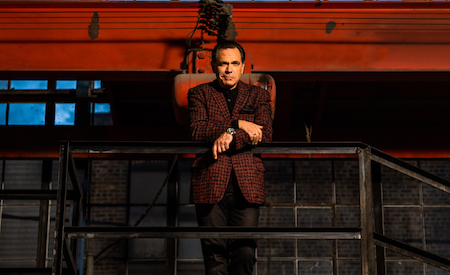
Kurt Elling’s SuperBlue sends the artist in a new direction.
(Photo: Cory DeWald)Still feeling the effects of a fiery, four-night run at Ronnie Scott’s in London, Kurt Elling — DownBeat’s Male Vocalist of the Year — was safely back in the music-filled lair of his Chicago home, but operating in a zone between exhaustion and exhilaration.
“They were really some of those peak nights that you remember for the rest of your life,” the baritone vocalist said, momentarily diverting his eyes from the Zoom camera as his 5-year-old son, August Gerhard, vied for his attention. “It’s like when you know you’re playing at the top of your current abilities, and everyone is pulling together.”
That was hardly preordained. Elling, known for employing seasoned jazz musicians, had instead surrounded himself with millennial groove masters Corey Fonville on drums and DJ Harrison on keyboards, along with two backup singers and his generational peer and producer, Charlie Hunter, a remarkably adaptable guitarist who has, along with his jazz chops, explored the world of hip-hop since the 1990s.
At first blush, the dance-club quality of the onstage assemblage might have seemed at odds with Elling’s sensibilities. But in the days of pandemic, a little change was in order. As he put it, this new mode of expression “was, and is, an ongoing COVID experience” — one conceived as a release from the stir-craziness acquired during lockdown, which consigned him to staring at a wall of plaques that honored a musical prowess he was unable to fully share.
The project began as a kind of persona-warping lark, its attendant album, SuperBlue (Edition), intended to involve Elling virtually. It became flesh-and-blood reality in the early-autumn engagement at Ronnie’s, where, for the first time, the band spent consecutive days together. From set to set, they said, the grooves became deeper, strengthening the foundation on which Elling could fashion fresh takes on some old-school mannerisms.
Since his earliest days in Windy City haunts, as part of a duo at Milt Trenier’s Show Lounge or with the house band at the Green Mill’s late jam, Elling had cultivated the wine-and-cocktails unflappability of crooners like Frank Sinatra and Peggy Lee, whom he heard as a boy on the car radio during family road trips. Tony Bennett became a lodestar after the youthful Elling saw him on TV performing live with the Woody Herman band.
“Here’s the band, and it’s roaring, and all the band is in black dinner suits and looking sharp,” he recalled. “And they say, ‘Now, ladies and gentlemen, Mr. Tony Bennett.’ And he comes out and he’s got a white dinner jacket on, and he gets to sing, and to sing like that. And I was like, ‘That’s the guy you want to be.’”
That, in no small measure, is the guy he became — and arguably more. On one level, he has developed into an interpreter of popular song whose presence on the scene has, without evident irony, kept alive a style and standard of presentation. His first Grammy for best jazz vocal album — earned for 2009’s Dedicated To You: Kurt Elling Sings The Music Of Coltrane And Hartman, recorded live as part of Lincoln Center’s American Songbook Series — is a case in point.
On another level, he has become an artful conveyer of meaning through words, an acolyte, then colleague of singer-writers like Jon Hendricks and Mark Murphy whose achievements in vocalese have added another dimension to jazz melodies.
His second Grammy, earned this year for Secrets Are The Best Stories (Edition), offers ample evidence. The album became a vehicle for some of his best poetry and, he said, for uncovering secrets pianist Danilo Pérez might hold by dint of his close association with Wayne Shorter.
In an age of cultural pluralists, Elling’s contributions to the pure jazz idiom are so profound that they can, to the uninitiated, seem almost anachronistic. No surprise there; they echo the obsessions of a self-described “dorky” kid who missed his time. Now 53, Elling wasn’t born into the generation from which his version of jazz singing emerged; he was, rather, surrounded in the streets by the sounds of funk and the stirrings of hip-hop. So when he decided to swing in that direction for the current project, it may have been late in coming — but it wasn’t a disorienting move for artist or audience. At Ronnie’s, the raves came from a younger crowd than Elling usually attracts.
“I knew that he could cut this shit,” Hunter said in a phone interview.
Hunter’s opinion was not offered in a vacuum. He and Elling met at Chicago’s Elbo Room in 1995, got to know each other as members of the Blue Note Records artist stable and over the years worked together in various settings — like a multidisciplinary show of Elling’s at the Steppenwolf Theater, an album of Hunter’s and a tour with drummer Derrek Phillips.
Early in the pandemic, Hunter and Elling — holed up in their homes and seeking a creative outlet — pieced together videos and uploaded them to the internet. In one, a so-called quarantine jam in which drummer Steve Hass joins them, Elling — sporting shades, a goatee, and a trilby hat — offers an improbably loose-limbed performance that now seems a possible precursor to the SuperBlue project.
“That gave Kurt the idea that maybe we can expand on this and make a record,” Hunter said.
Elling’s enthusiasm for the project was tempered by misgivings. And he said as much when Hunter suggested that the project go forward. “Charlie reached out and said, ‘Bro, I think now is the time,’” Elling recalled. “I said, ‘How are we even going to do that?’ I had a certain amount of trepidation coming into working with Charlie and Corey and DJ at this level because it’s not the usual stuff I do. It’s jazz adjacent.”
Because the project was “not in my primary wheelhouse,” Elling said, he was wary of being drawn into a research “labyrinth” in preparing for it. Recalling the rhetoric of doubt he voiced at the time, he said: “‘How much Roy Ayers do I have to listen to now? How am I going to get my hands on all this California soul?’”
But those who know him are unsurprised that he would meet the challenge. “His voice is God-given, but his work ethic and imagination are totally boundless,” said pianist Bill Charlap, who won a 2016 Grammy with Bennett and, as an impresario, has featured Elling singing standards at New York’s 92nd Street Y, in 2008 and, most recently, in July.
Agreeing to move forward, Elling passed the baton to Hunter. “It was up to me to make it happen,” Hunter said. So in November 2020, he drove north from his home in Greensboro, North Carolina, to Richmond, Virginia, where Fonville and Harrison lived, and the latter had a home studio in which the three could work. He made three or four such trips. In February, raw material in hand, he drove west to Urbana, Illinois, where he, Elling and engineer Anthony Gravino tracked and mixed the record.
“With this record,” Hunter explained, “I just wanted to write some great grooves that Kurt could turn into cool lyrical things.”
Apart from one tune — “Circus,” on which Elling recites Tom Waits’ words atop a freely improvised boogaloo — those grooves were cut in extended jams given structure by bodies of songs Hunter had brought to Richmond. Within those structures, the musicians were free to shape the material with few constraints beyond the general directive to create music to which Elling could apply his gifts.
Fonville, in a phone interview, described the sessions as relaxed: “We just let the tape roll and cut it up. He allowed us to just be ourselves.” Elling, he added, provided real-time feedback on the music, even as he worked on the words. “Kurt was on standby. He kept writing as we sent tracks to him from the studio.”
The effort yielded originals that project a sense of fun with serious undertones. Jammed with Elling’s bluesy rasp and lyrics by turns portentous and playful, they include “Manic Panic Ephanic,” a lightly baked COVID-era confection showcasing Harrison’s Wurlitzer and punctuated by a disquieting falsetto; “Can’t Make It With Your Brain,” a disquisition on disinformation driven by Hunter’s split-brain bass/rhythm guitar; “Dharma Bums,” a kicky nod to the Beats animated by Hunter’s wah-wah vibe; and “This Is How We Do,” a minute-long, voice-modulated fadeout that functions as an apt coda to the collection.
Writing credits on the originals go to the group, with and without Elling. But as the back-and-forth of the writing progressed and the workings of the Richmond bubble assumed a distinct form, Elling realized that something was needed beyond the collective compositions, and he asserted himself: “‘If it’s going to be like that,’” he recalled saying, “‘then I’ve got some jazz things I want to do.’”
The balance of the collection — save for a take on Cody Chestnutt’s R&B chestnut “The Seed” — thus became covers of jazz tunes. Overlaid with homage, they include the title track, a fusion artifact recalling the spirit of Freddie Hubbard; “Sassy,” a soul-based, bop-inflected Sarah Vaughan tribute first recorded by the Manhattan Transfer; “Where To Find It,” a swampy meditation on Shorter’s undulating ode to Burma’s now-fallen idol, “Aung San Suu Kyi”; and “Endless Lawns,” Carla Bley’s “Lawns” rendered as a slow burn.
“Endless Lawns” also appears in an appropriately expansive version on Elling’s acoustic album from 2018, The Questions. But in the charged context of SuperBlue, its restraint packs a particular punch: As an encore at Ronnie Scott’s, Fonville said, it struck a powerful chord as Elling traced Bley’s inviting intervals with a closing lyric that is as close to poignant as he is likely to come: “Come climb the sky with me/Come hear and come to see/Melody in perfect symmetry/In love./In light./In key.”
“It was a silent killer,” Fonville said. “Every time we played it, people teared up.”
Ever unflappable, Elling himself is not easily given to tears. But he did well up when recalling the kindnesses shown to him by elders like Chicago saxophone legend Von Freeman, who agreed to appear on what became Elling’s debut album for Blue Note, 1995’s Close Your Eyes. Perhaps the most surprising act of generosity he could summon also centered on that album — one in which a friend gave him $10,000 to make a studio-quality demo that, after reaching Blue Note Records’ then-chief Bruce Lundvall, prompted a contract signing and became the core of the collection. A Grammy nomination followed.
“It was a dream come true that I didn’t even know I could have,” he said.
Fourteen albums later, he is conjuring new dreams — reaching new audiences with SuperBlue, to be sure, but also with overseas projects like one he is undertaking with Scottish saxophonist Tommy Smith, who has recruited him to write lyrics on tunes by living European jazz composers. The dramatist in him is also taking center stage: Leading up to the Ronnie Scott’s gig, he mounted his radio play The Big Blind at the Detroit Jazz Festival. He also performed at Jazz at Lincoln Center’s centennial tribute to Hendricks.
With all the activity, he was obviously glad to be home, where son August was now a fidgety on-camera presence, trying to help Elling open a bubble-lined bag holding the plaque that recognized his honor this year as the Male Singer of the Year in the DownBeat Critics Poll. The win was his 17th; the plaque recognizing his 14th Readers Poll victory would soon be in the mail.
“It’s lovely,” he said, pointing to the plaques on the wall. “I treasure each and every shiny thing.”
Elling’s gratitude for the recognition represented by music awards was offered with the sincerity of a onetime divinity-school scholar who felt compelled to give up the study of Immanuel Kant for that of Jerome Kern (and, with the advent of SuperBlue, maybe a bit of Jay-Z). The decision, abandoning a lifetime of self-imposed expectations, had been a difficult one. But he has never looked back.
“It was like I had found True North.” DB
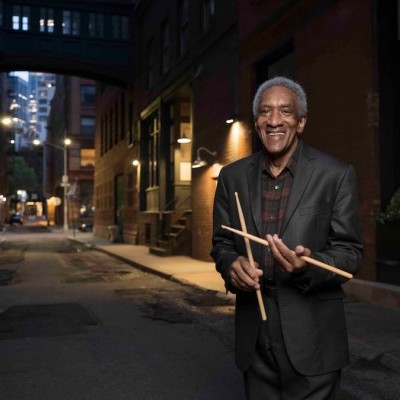
Foster was truly a drummer to the stars, including Miles Davis, Sonny Rollins and Joe Henderson.
Jun 3, 2025 11:25 AM
Al Foster, a drummer regarded for his fluency across the bebop, post-bop and funk/fusion lineages of jazz, died May 28…
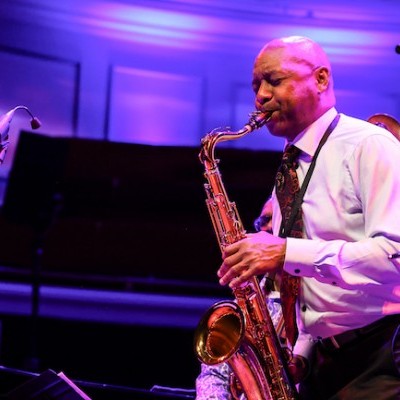
“Branford’s playing has steadily improved,” says younger brother Wynton Marsalis. “He’s just gotten more and more serious.”
May 20, 2025 11:58 AM
Branford Marsalis was on the road again. Coffee cup in hand, the saxophonist — sporting a gray hoodie and a look of…
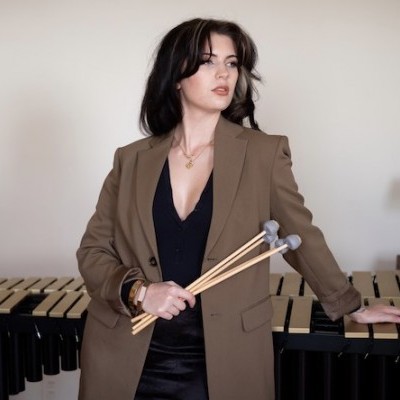
“What did I want more of when I was this age?” Sasha Berliner asks when she’s in her teaching mode.
May 13, 2025 12:39 PM
Part of the jazz vibraphone conversation since her late teens, Sasha Berliner has long come across as a fully formed…

Roscoe Mitchell will receive a Lifetime Achievement award at this year’s Vision Festival.
May 27, 2025 6:21 PM
Arts for Art has announced the full lineup for the 2025 Vision Festival, which will run June 2–7 at Roulette…
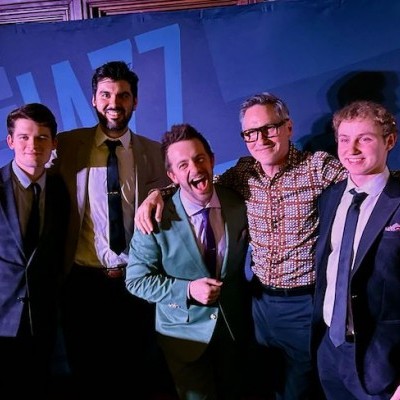
Benny Benack III and his quartet took the Midwest Jazz Collective’s route for a test run this spring.
Jun 3, 2025 10:31 AM
The time and labor required to tour is, for many musicians, daunting at best and prohibitive at worst. It’s hardly…